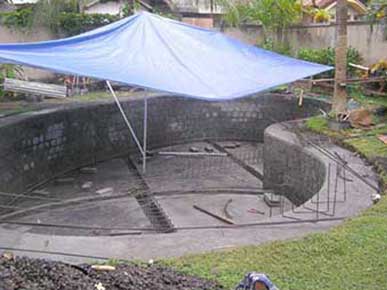Swimming Pool Design and Construction
Important considerations when designing and constructing a swimming pool

We all like the idea of having a swimming pool but pools are expensive to built and maintain. It is important that pools are designed and constructed properly by people with the skills and professional expertise to do the job properly.
Many problems with pools can be repaired however a poorly built pool can crack and leak and very often it is not possible to repair leaks of this type.
Let us look at the design and construction of swimming pools, the factors we should think of before the pool is designed, the need for sound structural engineering and competent construction with high strength reinforced steel.
Finally let us consider if it is possible to repair a leaking pool.
See also:
In another article we looked at different types of swimming pools and of these by far the most common are pools made from reinforced concrete. Let us look at the function and design requirements of a concrete swimming pool and the important aspects of its construction.
Swimming Pool Design
When we design a pool we have to consider a number of factors:
Design Factors
How big it should be and what shape.
To decide this we need to consider who will use your pool and what it will be used for. If it is for laps it needs to be long and straight but can be narrow and shallow.
For visual effect you may want it curved, perhaps a kidney or gall bladder shape rather than rectangular.
Depth needs special consideration. Some people these days are building very deep swimming pools with no shallow end. Very good for washing your elephant but not very practical for general purpose use and can be downright dangerous for children. If children are going to play in it you do not want it too deep - 1 metre is plenty for children under 12 years old. Bear in mind that an average adult's shoulder height is around 1.5 metres while a toddler can easily drown in water only 30 cms deep.
If you will use it for romantic evening soirees you really don't want it 2 metres deep. If you plan to dive into it from the side or from a board you may want it deeper. If you plan to practice scuba diving, you want a diving board on your balcony or you plan to drown that annoying neighbour you might want it 2 or even 3 metres deep.
The traditional pool with a shallow end for the children to play in and a deep end for diving is a sensible multi purpose design.
The Depth and Volume of Water
A large or deep pool will cost a lot more to maintain than a smaller pool particularly in electricity costs for the water circulation pump. Note that only a small increases in size can greatly increase the volume of water. A 4 metre by 5 metre pool by 1.6 metre deep contains 32 cubic metres of water, only a small increase to 5 metres by 6 metres and the depth to 2 metres and the water volume is now up to 60 cubic metres - twice the water to circulate and treat.
Getting in and Out
These days with so much emphasis on safety how people will get in and out of the pool is considered important. Especially think about how a young or old person who inadvertently falls in can get out. Stainless steel ladders are very efficient with space but not the easiest to use. If you build steps into the pool these should be shallow enough to make them easy to climb up and down.
Pool Lining
What sort of lining do you wish to use? Tiles are more expensive but give you a longer lasting, low maintenance finish that looks good. Paint can cause problems particularly when that former wafter of satay sticks doesn't know how to apply specialist paint on challenging surfaces.
Swimming Pool Technical Design
Of course the most basic requirement for a swimming pool is to provide a container for water. The concrete "shell" must not leak and it must be strong enough to resist cracking and ground movement.
Pools should be designed by Structural Engineers
It is important to remember that water is very heavy stuff and a typical small pool of 4 metres by 5 metres by 1.6 metres deep will contain 32 metric tons of water. For this reason swimming pools should be designed by civil or structural eginners, people who can work out the enormous stresses and strains and design the pool accordingly.
The ground around the pool will provide support and this will vary according to the type of ground. If the ground is firm (such as clay) the pool will probably have plenty of support from the surrounding ground. If, however, the ground is light and porous or has been eroded by water flow around or under the pool there may be air voids present which can reduce the support for the pool and this may result in stress concentration in particular places in the walls or floor of the pool.
If the pool is against firm ground on one side but with no support on the other, or much worse, cantilevered off a hillside the stresses on the pool can become enormous and it is imperative that proper engineering design is carried out. You might notice that there are some pools that are cantilevered off hillsides to give a dramatic effect but, while many are well designed and constructed, there are many more that can only be considered as tempting fate.
The strength of the Pool Shell
The walls and bottom of the pool must be rigid enough to hold the water without flexing because flexing will crack the concrete. The reinforcing steel must be correctly designed and have sufficient coverage of dense concrete (6 cms coverage is advisable) to protect it from rusting.
The concrete in the walls and bottom of a swimming pool are built in the same way that a concrete floor is constructed. We make a mesh of steel bars and embed it in concrete. Steel bends fairly easily and if we use only one layer of steel mesh in the concrete floor it will sag in the middle. If we use two layers of steel mesh with a gap between them this will stop the floor from sagging. The same applies to the walls and bottom of a swimming pool, we need two layers of mesh with a gap between to resist flexing.
Swimming Pool Construction

It is very important to find a competent contractor who understands reinforced concrete
It is also very important that the concrete shell, both the walls and bottom of the pool, are cast as a single piece of concrete. If we cast the bottom first and then the sides afterwards we will have a joint where the walls meet the bottom which is likely to leak.
We also need to use a vibrator when we place the concrete to make sure it is dense with no air bubbles in it. Many builders don't use vibrators and think a few pokes with an iron bar are enough - not so - you need to use a vibrator. It is also a good idea to make the concrete is strong and K300 is advisable. Many builders don't know what K300 concrete is, those that do may well think this is all far too difficult and have palpitations at the very thought. The truth is that, if you know what you are doing, it is not difficult to achieve 300K concrete. See our section on concrete mixtures for more information.
Circulation and drainage pipes
Before we cast the concrete shell we must install the water circulation pipework for the pool and most importantly the drains in the bottom. These MUST be installed properly. You will only find out that the plumber forgot to glue the joints (a surprisingly common occurrence) once the pool is complete and full of water and, unless you have some background of tunnelling into bank faults or a well trained mole, it is a tad difficult to get under the pool to seal it.
Electrical Installations
Conduits for pool lighting wiring needs to be well designed and built into the pool shell in such a way that they are electrically safe, can maintained and do not leak. NOTE pool lighting must always use low voltage (12 volts) for lighting or other poolside services.
Once cast the pool shell is lined with a water proofing agent (just to make sure) followed by a cement "screed" (a thin layer of cement which may be anything from 2 cms to 8 cms thick) and finished with ceramic tiles or with a pool paint. In the bottom of the pool the "screed" is used to shape the bottom of the pool so that water will flow towards the drains. Tiles may be ceramic or of stone and are finished with a standard grout.
Leaking Swimming Pools
A leaking swimming pool can be very difficult to repair and most pool construction companies will not be interested in trying to repair one. It is, therefore, very important to build a pool properly in the first place and this is a task you should not place in the hands of a questionable contractor.
Water is sneaky stuff. It squeezes in between the tiles then wanders around behind them till it finds a crack in the cement screed. On getting thorough this crack it creeps around behind the screed until it finds a crack in the reinforced concrete and escapes to the outside world. By the time it escapes it has travelled a long way from where it first got through the tiles, what chance have we got to find such a leak?
Can a leaking Pool Be Repaired?
If you know what you are doing some leaks can be found and repaired. Firstly ask the question "Is the pool leaking." Bear in mind that the water level will fall each day through evaportaion and the rate of evaporation may speed up on hot or very dry days.
Next we have to determine exactly where the pool is leaking.
Leaks in pipes, pump rooms and balancing tanks.
Leaks may often occur in pipework or where pipes pass through the concrete, there are specialised ways of finding and sealing these. Leaks can also occur in the pump room or balancing tank and these can usually be fairly easily repaired.
Cracked pool shell
The worst case is if the pool shell itself is leaking. If this is a defect in the concrete or a hole that has not been sealed then the pool shell may be repairable however, if the pool shell has been poorly built and has cracked because it wasn't strong enough it is highly likely that nothing can be done.
In some cases such pools can be saved by "recycling" them, a new pool can be cast inside the old one. If the leak is a crack in the concrete shell there are usually few options - demolish and start again.
See also:
Phil Wilson
Copyright © Phil Wilson January 2015
This article, or any part of it, cannot be copied or reproduced without permission from the copyright owner.
